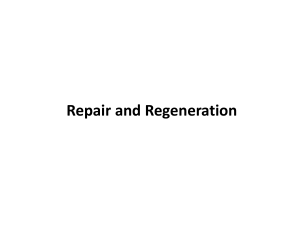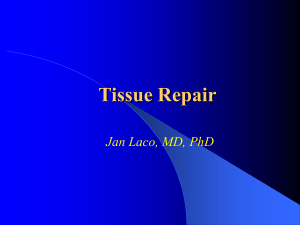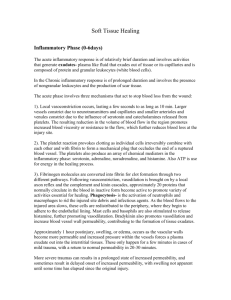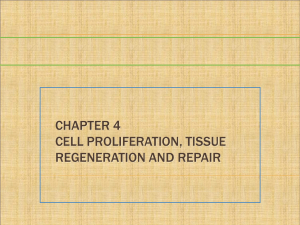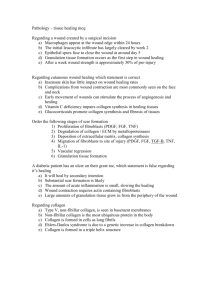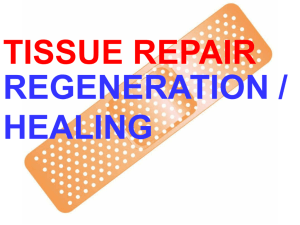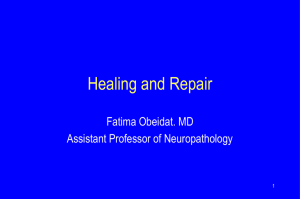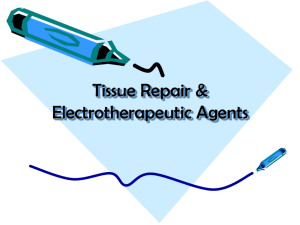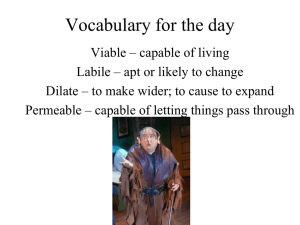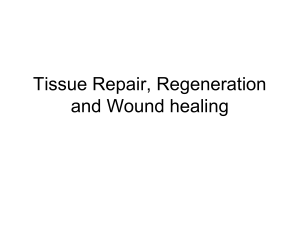Pathology PHT 218 Unit 3 Repair and Regeneration
advertisement
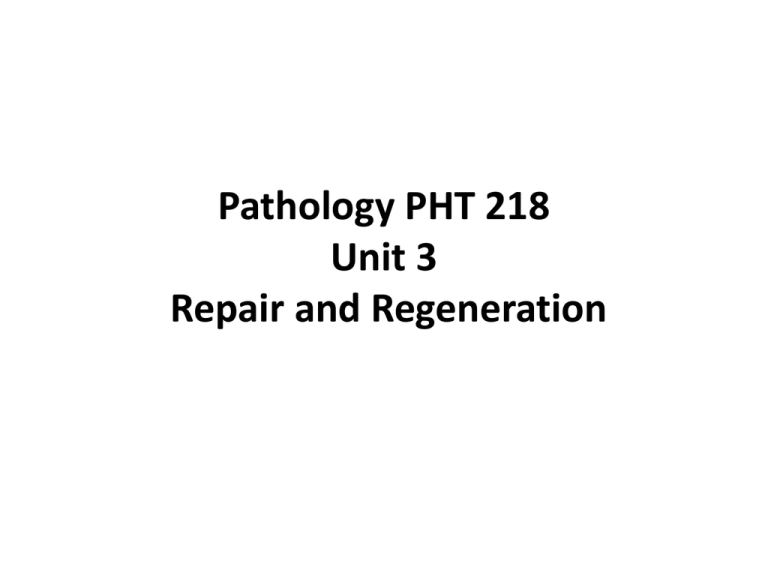
Pathology PHT 218 Unit 3 Repair and Regeneration Repair and Regeneration Tissue Repair may start early after tissue damage • 1. Regeneration – Restoration of original tissue architecture and function – by parenchymal cells of the same type • 2. Repair – Replacement by connective tissue (scarring) – There will be alterations in both architecture and function Regeneration: Cell requirements CELLULAR PROLIFERATION Tissues of the body are divided into three groups: • Continuously dividing (labile) tissues • Stable tissues • Permanent tissues Tissue types 1. permanent • nonproliferative in postnatal life • neurons , cardiomyocytes 2. stable • regeneration as response to injury • parenchyma – liver, pancreas, renal tubule 3. labile • continuous regeneration from stem cells (self-renewal) • hematopoietic cells in bone marrow • surface epithelia – skin, oral cavity, vagina, cervix • duct epithelia – salivary glands, pancreas, biliary tract • mucosas – GIT, uterus, fallopian tubes, urinary bladder CELLULAR PROLIFERATION Tissues of the body are divided into three groups: • Continuously dividing (labile) tissues • • • • cells are continuously proliferating can easily regenerate after injury contain a pool of stem cells examples: bone marrow, skin, GI epithelium CELLULAR PROLIFERATION • Stable tissues • • • • cells have limited ability to proliferate limited ability to regenerate (except liver!) normally in body, but can proliferate if injured examples: liver, kidney, pancreas CELLULAR PROLIFERATION • Permanent tissues • cells can’t proliferate • can’t regenerate (so injury always leads to scar) • examples: neurons, cardiac muscle The Cell Cycle and Different Cell Populations The parenchyma are the functional parts of an organ in the body. This is in contrast to the stroma, which refers to the structural tissue of organs, namely, the connective tissues. Organ brain heart kidney liver Parenchyma neurons and glial cells myocyte nephron hepatocyte lungs pancreas spleen Lung parenchyma Islets of Langerhans and Pancreatic acini white pulp and red pulp Regeneration • Regeneration results in the replacement of lost cells by their own kind, thereby returning the tissue to normal structure and function • Labile or stable cells • Intact stroma (connective tissue) and basement membranes • Parenchymal cells (functional cells) migrate across existing stromal framework and multiply to restore tissue integrity . Regeneration: Hindrances • Destruction of stroma – disturbed proliferation of parenchymal cells – Replacement of stroma • Excessive exudation/infection • Polymorphonucleocytes(PMNs) secrete numerous proteases (collagenases, elastases) which digest the basement membrane and supporting connective tissues • Bacteria often have similar enzymes and/or toxins which may kill the parenchymal or inflammatory cells • Excessively large defects • Permanent cells Repair • When the requirements for regeneration are not met, then the gaps produced by lost cells heal by connective tissue replacement • Repair by fibrous tissue/connective tissue/ granulation tissue • Wound healing Cell-ECM interactions • • • • • not only cells! EMC plays important role in healing interstitial matrix – by fibroblasts basement membrane – by fibroblast and epithelium components – Collagen, elastin, fibrillin, glycoproteins and proteoglycans and hyalouronans. Cell-ECM interactions • ECM function – mechanical support – determination of cell polarity – control of cell growth – maintenance of cell proliferation – establishment of tissue microenvironments – storage of regulatory molecules Replacement of necrotic tissue • resorption by macrophages • dissolution by enzymes • replacement by granulation tissue – uniform mechanism irrespective of inicial trigger – the same microscopic appearance – The steps are: 1. angiogenesis 2. migration and proliferation of fibroblasts 3. deposition of ECM 4. maturation and reorganization Repair by Connective Tissue • Conditions for regeneration are not met • Four components to this process: 1. Formation of new blood vessels (angiogenesis) 2. Migration and proliferation of fibroblasts (fibroblast is a type of cell that synthesizes the extracellular matrix and collagen, the structural framework ) 3. Deposition of Extracellular matrix, synthesis of collagen (scar formation) 4. Maturation, contraction, and organization of fibrous tissue (remodeling of scar) Granulation tissue • • • • • new-formed connective tissue, apparent from 3rd day thin-walled capillary vessels fibroblasts loose extracellular matrix stimulation – PDGF, VEGF, FGF, TGF, TNF, EGF • inhibition – INFalfa, prostaglandins, angiostatins • control – cyclins, cyclin dependent kinases Granulation tissue • • • • • pink soft granular appearance richly vascularized highly cellular myxoid matrix inflammatory cells • e.g. surface of wounds, bottom of ulcers 1. Angiogenesis • • • • • • neovascularization x vasculogenesis (embryonic process only) highly complex phenomenon angiogenic factors (FGF, VEGF) antiangiogenic factors healing, collateral circulation, tumors 1. Angiogenesis 2. Role of (Fibrosis) Fibroplasia • Fibroblasts proliferate replace fibronectin-fibrin with collagen contribute ECM • Fibroplasia – fibrous repair – – – – Formulation of Granulation tissue Infiltration of fibroblasts Collagen laid down in random pattern Scar tissues excessive if inflammation re-initiated 3. Role of extracellular matrix in wound healing and scar formation • Extracellular matrix (ECM) is formed by specific secreted macromolecules that form a network on which cells grow and migrate along • ECM proteins assemble into two general organizations – Interstitial matrix (present between cells) – Basement membrane [BM] (produced by epithelial and mesenchymal cells and is closely associated with the cell surface) Three groups of macromolecules constitute the ECM 1. Fibrous structural proteins – Collagen(18 types) – I, III, IV, V; tensile strength – elastin (+ fibrillin) – return to normal structure after stress 2. Adhesive glycoproteins – adhesion, binding ECM to cells (fibronectin, laminin) 3. Proteoglycans and Hyaluronic Acid(hyalouronans) - lubrication (gels) 4. Maturation & Remodeling – Initial scar formation takes weeks – Scar matures • Longest part of inflammation (over 1 yr) • Re-absorb temporary vasculature – Scar shrinks (contraction) & changes color – Scar remodels • Collagen fibers re-align with stress (SAID) • Less tensile strength than tissue it replaces The phases of cutaneous wound healing Injury leads to accumulation of platelets and coagulation factors. Coagulation results in fibrin formation and release of PDGF and TGF-b and other inflammatory mediators by activated platelets. This leads to more Neutrophil recruitment which signals the beginning of inflammation (24 h). After 48 h macrophages replace neutrophils. Neutrophils and macrophages are responsible for removal of cellular debris and release growth factors to reorganize the cellular matrix. At 72 hours the proliferation phase begins as recruited fibroblasts stimulated by FGF and TFGb begin to synthesize collagen. Previously formed fibrin forms initial matrix for fibroblasts Collagen cross-linking and reorganization occurs following months after injury in the remodeling phase of repair. Wound contraction follows in large surface wounds and is facilitated by actin-containing fibroblasts (myofibroblasts) Skin Wound healing Skin wounds are classically described to heal by either primary or secondary intention and the distinction is made by the nature and extent of the wound First intention healing Second intention healing wounds with clean opposing edges (surgical incision, should form a narrow scar due to small amount of granulation tissue required to fill the gap) wounds with separated edges (trauma that requires abundance of granulation tissue for wound closure) Pathological aspects of healing • proud flesh (caro luxurians) – excessive amount of Granulation tissue(GT) • keloid – excessive amount of collagen • hyaline plaques – serous membranes (spleen, pleura) Complications of wound healing • Deficient scar formation – Wound dehiscence (premature "bursting" open of a wound along surgical suture) – Ulceration • Excessive formation of scar tissue – Keloid (excessive collagen deposition) – Desmoid (aggressive fibromatosis, semi-malignant) • Contracture Wound dehiscence Keloid Wound ulceration Contracture Keloids: Beyond the Borders • Excess Deposition of Collagen Causes Scar Growth Beyond the Border of the Original wound Tx: XRT, steroids, silicone sheeting, pressure, excise. often Refractory to Tx & not preventable Factors that influence wound healing I. Systemic factors • Malnutrition – Protein deficiency – Vitamin C deficiency (inhibition of collagen synthesis) • Metabolic status – e.g Diabetes mellitus • Consequence of microangiopathy – Cortison treatment • inhibits inflammation and collagen synthesis • Circulatory status – Inadequate blood supply due to ateriosclerosis – Varicose veins (retarded venous drainage) Factors that influence wound healing II. Local Factors • Infection (single most important reason for delayed wound healing) • Foreign bodies – suture material, bone and wood splinters …. • Mechanical factors – Early movement – Pressure
